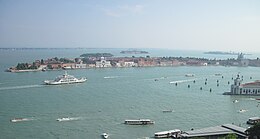Giudecca
 View of Giudecca from St Mark's Campanile | |
Location in the Venetian Lagoon | |
| Geography | |
|---|---|
| Coordinates | 45°25′31″N 12°19′35″E / 45.425142°N 12.326482°E |
| Adjacent to | Venetian Lagoon |
| Administration | |
| Comune | Venice |
Giudecca (Italian: [dʒuˈdɛkka]; Venetian: Zueca) is an island in the Venetian Lagoon, in northern Italy. It is part of the sestiere of Dorsoduro and is a locality of the comune of Venice.
Geography
Giudecca lies immediately south of the central islands of Venice, from which it is separated by the Giudecca Canal. San Giorgio Maggiore lies off its eastern tip.
History
Giudecca was known in ancient times as the Spinalunga (meaning "Long Thorn"). The name Giudecca may represent a corruption of the Latin "Judaica" ("Judaean") and so may be translated as "the Jewry": a number of towns in Southern Italy and Sicily have Jewish quarters named Giudecca or Judeca. Venice historian John Julius Norwich writes in the 1989 edition of his book, A History of Venice: “…by the middle of the thirteenth century there was already a considerable Jewish population in the city and its immediate neighborhood—perhaps 3,000 or more. Many lived at Mestre, on the mainland; others —particularly those who had mercantile dealings with Dalmatia—occupied the island of Spinalunga and were in fact responsible for its change of name to Giudecca.” However, the term "Giudecca" was not generally used to denote the Jewish quarters of towns in northern Italy.
It wasn't until 1516 that the first segregated Jewish quarter in Europe, called the New Foundry, or "Ghetto Nuovo," was established in the Cannaregio district in Venice. Jews were required to live in a confined area and were subject to various restrictions. The term "ghetto" itself originated from this Venetian district.
Giudecca was historically an area of large palaces with gardens, the island became an industrial area in the early 20th century with shipyards and factories, and a film studio. Much of the industry went into decline after World War II, but it is now once more regarded as a quiet residential area of largely working-class housing with some chic apartments and exclusive houses. It is known for its long dock and its churches, including the Palladio-designed Il Redentore. The island was the home of a huge flour mill, the Molino Stucky, which has been converted into a luxury hotel and apartment complex. At the other end of Giudecca is the famous five-star Cipriani hotel with large private gardens and salt-water pool.
Resort town
Modern renovations of some antique architecture in Giudecca have bolstered the island's reputation as a vacation locale. In 2011, Venetian developers reopened the lodgings of a prominent 16th-century mansion as long-term rentals under the name "Villa F."[1]
Gallery
- Il Redentore church
- The pier that connects Giudecca with Venice during the Festa del Redentore in July
- Le Zitelle church
- The modern Junghans quarter
- Junghans contemporary theater, seat of the Venetian Theatrical Academy
- Aerial view of the Giudecca Canal (left)
See also
References
- ^ Lawrence, Vanessa (September 2011). "La Dolce Villa". W. Condé Nast: 276. Archived from the original on 8 June 2013. Retrieved 11 March 2012.







